Geraldo F. Oliveira
TransPimLib: A Library for Efficient Transcendental Functions on Processing-in-Memory Systems
Apr 23, 2023



Abstract:Processing-in-memory (PIM) promises to alleviate the data movement bottleneck in modern computing systems. However, current real-world PIM systems have the inherent disadvantage that their hardware is more constrained than in conventional processors (CPU, GPU), due to the difficulty and cost of building processing elements near or inside the memory. As a result, general-purpose PIM architectures support fairly limited instruction sets and struggle to execute complex operations such as transcendental functions and other hard-to-calculate operations (e.g., square root). These operations are particularly important for some modern workloads, e.g., activation functions in machine learning applications. In order to provide support for transcendental (and other hard-to-calculate) functions in general-purpose PIM systems, we present \emph{TransPimLib}, a library that provides CORDIC-based and LUT-based methods for trigonometric functions, hyperbolic functions, exponentiation, logarithm, square root, etc. We develop an implementation of TransPimLib for the UPMEM PIM architecture and perform a thorough evaluation of TransPimLib's methods in terms of performance and accuracy, using microbenchmarks and three full workloads (Blackscholes, Sigmoid, Softmax). We open-source all our code and datasets at~\url{https://github.com/CMU-SAFARI/transpimlib}.
Accelerating Neural Network Inference with Processing-in-DRAM: From the Edge to the Cloud
Sep 19, 2022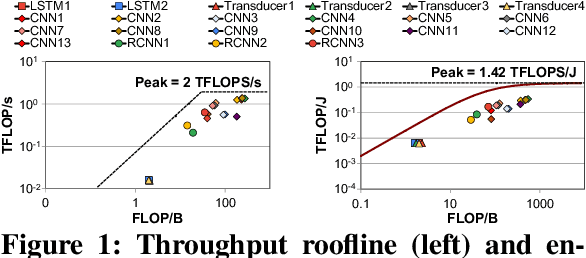
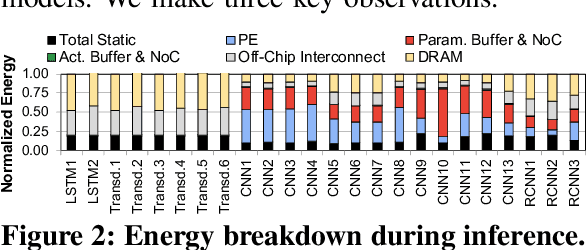
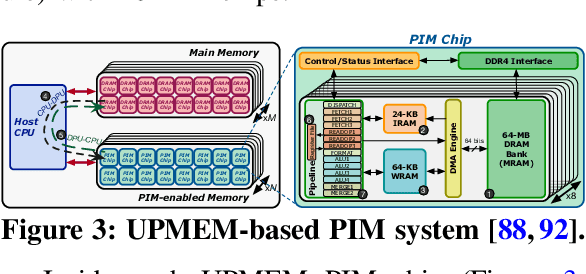

Abstract:Neural networks (NNs) are growing in importance and complexity. A neural network's performance (and energy efficiency) can be bound either by computation or memory resources. The processing-in-memory (PIM) paradigm, where computation is placed near or within memory arrays, is a viable solution to accelerate memory-bound NNs. However, PIM architectures vary in form, where different PIM approaches lead to different trade-offs. Our goal is to analyze, discuss, and contrast DRAM-based PIM architectures for NN performance and energy efficiency. To do so, we analyze three state-of-the-art PIM architectures: (1) UPMEM, which integrates processors and DRAM arrays into a single 2D chip; (2) Mensa, a 3D-stack-based PIM architecture tailored for edge devices; and (3) SIMDRAM, which uses the analog principles of DRAM to execute bit-serial operations. Our analysis reveals that PIM greatly benefits memory-bound NNs: (1) UPMEM provides 23x the performance of a high-end GPU when the GPU requires memory oversubscription for a general matrix-vector multiplication kernel; (2) Mensa improves energy efficiency and throughput by 3.0x and 3.1x over the Google Edge TPU for 24 Google edge NN models; and (3) SIMDRAM outperforms a CPU/GPU by 16.7x/1.4x for three binary NNs. We conclude that the ideal PIM architecture for NN models depends on a model's distinct attributes, due to the inherent architectural design choices.
An Experimental Evaluation of Machine Learning Training on a Real Processing-in-Memory System
Jul 16, 2022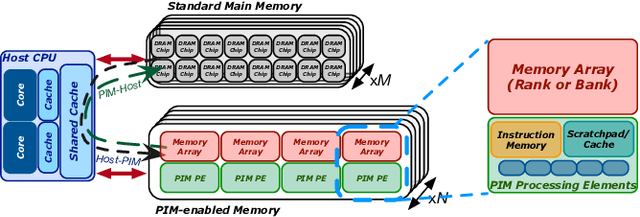
Abstract:Training machine learning (ML) algorithms is a computationally intensive process, which is frequently memory-bound due to repeatedly accessing large training datasets. As a result, processor-centric systems (e.g., CPU, GPU) suffer from costly data movement between memory units and processing units, which consumes large amounts of energy and execution cycles. Memory-centric computing systems, i.e., with processing-in-memory (PIM) capabilities, can alleviate this data movement bottleneck. Our goal is to understand the potential of modern general-purpose PIM architectures to accelerate ML training. To do so, we (1) implement several representative classic ML algorithms (namely, linear regression, logistic regression, decision tree, K-Means clustering) on a real-world general-purpose PIM architecture, (2) rigorously evaluate and characterize them in terms of accuracy, performance and scaling, and (3) compare to their counterpart implementations on CPU and GPU. Our evaluation on a real memory-centric computing system with more than 2500 PIM cores shows that general-purpose PIM architectures can greatly accelerate memory-bound ML workloads, when the necessary operations and datatypes are natively supported by PIM hardware. For example, our PIM implementation of decision tree is $27\times$ faster than a state-of-the-art CPU version on an 8-core Intel Xeon, and $1.34\times$ faster than a state-of-the-art GPU version on an NVIDIA A100. Our K-Means clustering on PIM is $2.8\times$ and $3.2\times$ than state-of-the-art CPU and GPU versions, respectively. To our knowledge, our work is the first one to evaluate ML training on a real-world PIM architecture. We conclude with key observations, takeaways, and recommendations that can inspire users of ML workloads, programmers of PIM architectures, and hardware designers & architects of future memory-centric computing systems.
Machine Learning Training on a Real Processing-in-Memory System
Jun 13, 2022
Abstract:Training machine learning algorithms is a computationally intensive process, which is frequently memory-bound due to repeatedly accessing large training datasets. As a result, processor-centric systems (e.g., CPU, GPU) suffer from costly data movement between memory units and processing units, which consumes large amounts of energy and execution cycles. Memory-centric computing systems, i.e., computing systems with processing-in-memory (PIM) capabilities, can alleviate this data movement bottleneck. Our goal is to understand the potential of modern general-purpose PIM architectures to accelerate machine learning training. To do so, we (1) implement several representative classic machine learning algorithms (namely, linear regression, logistic regression, decision tree, K-means clustering) on a real-world general-purpose PIM architecture, (2) characterize them in terms of accuracy, performance and scaling, and (3) compare to their counterpart implementations on CPU and GPU. Our experimental evaluation on a memory-centric computing system with more than 2500 PIM cores shows that general-purpose PIM architectures can greatly accelerate memory-bound machine learning workloads, when the necessary operations and datatypes are natively supported by PIM hardware. To our knowledge, our work is the first one to evaluate training of machine learning algorithms on a real-world general-purpose PIM architecture.
Heterogeneous Data-Centric Architectures for Modern Data-Intensive Applications: Case Studies in Machine Learning and Databases
May 29, 2022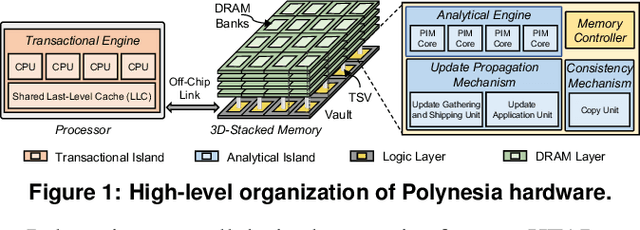
Abstract:Today's computing systems require moving data back-and-forth between computing resources (e.g., CPUs, GPUs, accelerators) and off-chip main memory so that computation can take place on the data. Unfortunately, this data movement is a major bottleneck for system performance and energy consumption. One promising execution paradigm that alleviates the data movement bottleneck in modern and emerging applications is processing-in-memory (PIM), where the cost of data movement to/from main memory is reduced by placing computation capabilities close to memory. Naively employing PIM to accelerate data-intensive workloads can lead to sub-optimal performance due to the many design constraints PIM substrates impose. Therefore, many recent works co-design specialized PIM accelerators and algorithms to improve performance and reduce the energy consumption of (i) applications from various application domains; and (ii) various computing environments, including cloud systems, mobile systems, and edge devices. We showcase the benefits of co-designing algorithms and hardware in a way that efficiently takes advantage of the PIM paradigm for two modern data-intensive applications: (1) machine learning inference models for edge devices and (2) hybrid transactional/analytical processing databases for cloud systems. We follow a two-step approach in our system design. In the first step, we extensively analyze the computation and memory access patterns of each application to gain insights into its hardware/software requirements and major sources of performance and energy bottlenecks in processor-centric systems. In the second step, we leverage the insights from the first step to co-design algorithms and hardware accelerators to enable high-performance and energy-efficient data-centric architectures for each application.
Google Neural Network Models for Edge Devices: Analyzing and Mitigating Machine Learning Inference Bottlenecks
Sep 29, 2021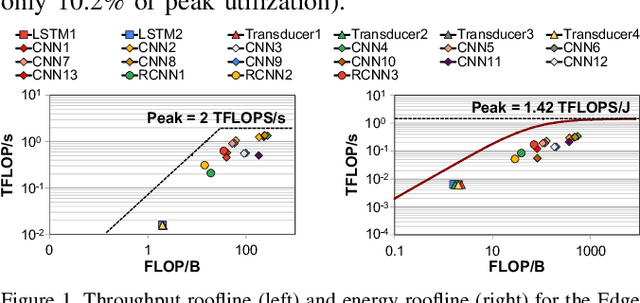
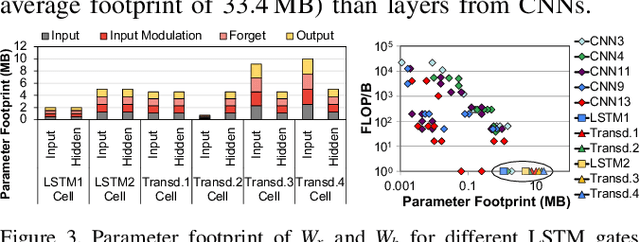
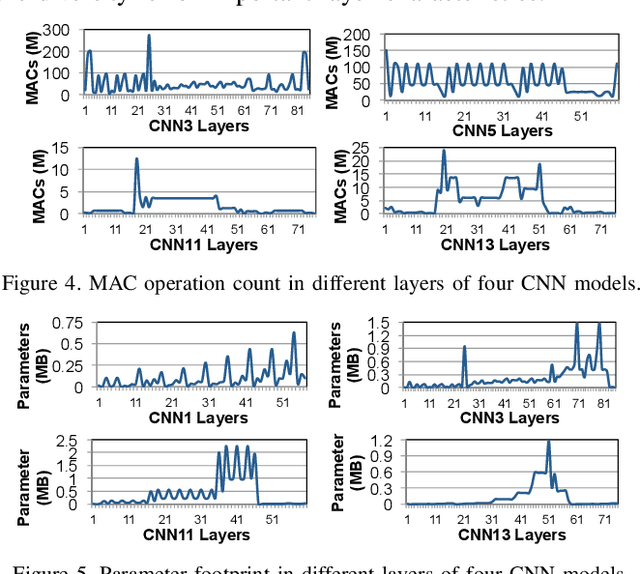
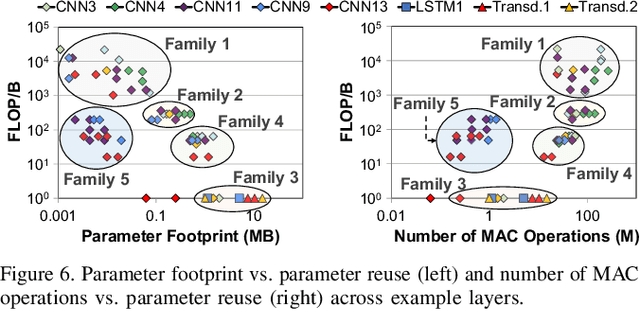
Abstract:Emerging edge computing platforms often contain machine learning (ML) accelerators that can accelerate inference for a wide range of neural network (NN) models. These models are designed to fit within the limited area and energy constraints of the edge computing platforms, each targeting various applications (e.g., face detection, speech recognition, translation, image captioning, video analytics). To understand how edge ML accelerators perform, we characterize the performance of a commercial Google Edge TPU, using 24 Google edge NN models (which span a wide range of NN model types) and analyzing each NN layer within each model. We find that the Edge TPU suffers from three major shortcomings: (1) it operates significantly below peak computational throughput, (2) it operates significantly below its theoretical energy efficiency, and (3) its memory system is a large energy and performance bottleneck. Our characterization reveals that the one-size-fits-all, monolithic design of the Edge TPU ignores the high degree of heterogeneity both across different NN models and across different NN layers within the same NN model, leading to the shortcomings we observe. We propose a new acceleration framework called Mensa. Mensa incorporates multiple heterogeneous edge ML accelerators (including both on-chip and near-data accelerators), each of which caters to the characteristics of a particular subset of NN models and layers. During NN inference, for each NN layer, Mensa decides which accelerator to schedule the layer on, taking into account both the optimality of each accelerator for the layer and layer-to-layer communication costs. Averaged across all 24 Google edge NN models, Mensa improves energy efficiency and throughput by 3.0x and 3.1x over the Edge TPU, and by 2.4x and 4.3x over Eyeriss~v2, a state-of-the-art accelerator.
Mitigating Edge Machine Learning Inference Bottlenecks: An Empirical Study on Accelerating Google Edge Models
Mar 01, 2021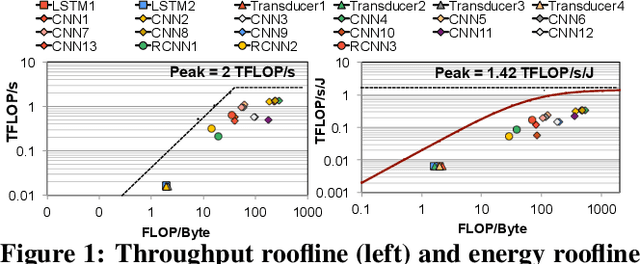
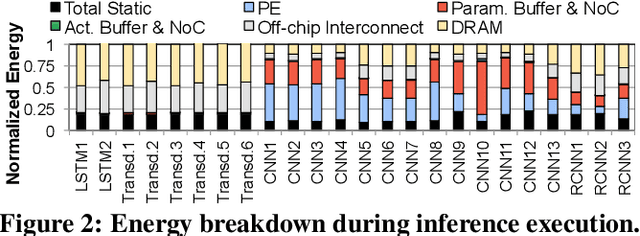
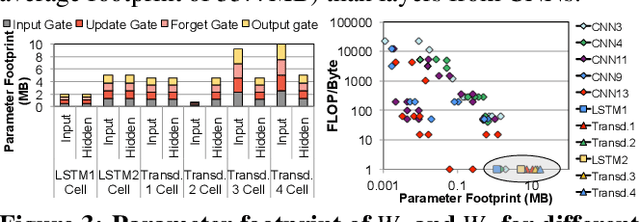
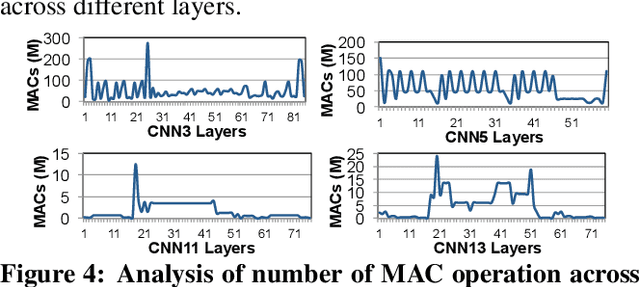
Abstract:As the need for edge computing grows, many modern consumer devices now contain edge machine learning (ML) accelerators that can compute a wide range of neural network (NN) models while still fitting within tight resource constraints. We analyze a commercial Edge TPU using 24 Google edge NN models (including CNNs, LSTMs, transducers, and RCNNs), and find that the accelerator suffers from three shortcomings, in terms of computational throughput, energy efficiency, and memory access handling. We comprehensively study the characteristics of each NN layer in all of the Google edge models, and find that these shortcomings arise from the one-size-fits-all approach of the accelerator, as there is a high amount of heterogeneity in key layer characteristics both across different models and across different layers in the same model. We propose a new acceleration framework called Mensa. Mensa incorporates multiple heterogeneous ML edge accelerators (including both on-chip and near-data accelerators), each of which caters to the characteristics of a particular subset of models. At runtime, Mensa schedules each layer to run on the best-suited accelerator, accounting for both efficiency and inter-layer dependencies. As we analyze the Google edge NN models, we discover that all of the layers naturally group into a small number of clusters, which allows us to design an efficient implementation of Mensa for these models with only three specialized accelerators. Averaged across all 24 Google edge models, Mensa improves energy efficiency and throughput by 3.0x and 3.1x over the Edge TPU, and by 2.4x and 4.3x over Eyeriss v2, a state-of-the-art accelerator.
 Add to Chrome
Add to Chrome Add to Firefox
Add to Firefox Add to Edge
Add to Edge